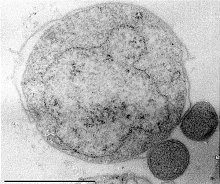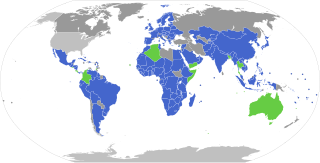Related Research Articles

The Convention on Biological Diversity (CBD), known informally as the Biodiversity Convention, is a multilateral treaty. The convention has three main goals: the conservation of biological diversity ; the sustainable use of its components; and the fair and equitable sharing of benefits arising from genetic resources. Its objective is to develop national strategies for the conservation and sustainable use of biological diversity, and it is often seen as the key document regarding sustainable development.

The World Intellectual Property Organization is one of the 15 specialized agencies of the United Nations (UN). Pursuant to the 1967 Convention Establishing the World Intellectual Property Organization, WIPO was created to promote and protect intellectual property (IP) across the world by cooperating with countries as well as international organizations. It began operations on 26 April 1970 when the convention entered into force. The current Director General is Singaporean Daren Tang, former head of the Intellectual Property Office of Singapore, who began his term on 1 October 2020.

Bioprospecting is the exploration of natural sources for small molecules, macromolecules and biochemical and genetic information that could be developed into commercially valuable products for the agricultural, aquaculture, bioremediation, cosmetics, nanotechnology, or pharmaceutical industries. In the pharmaceutical industry, for example, almost one third of all small-molecule drugs approved by the U.S. Food and Drug Administration (FDA) between 1981 and 2014 were either natural products or compounds derived from natural products.

Nanoarchaeota are a phylum of the Archaea. This phylum currently has only one representative, Nanoarchaeum equitans.

The Thermoproteota are archaea that have been classified as a phylum of the Archaea domain. Initially, the Thermoproteota were thought to be sulfur-dependent extremophiles but recent studies have identified characteristic Thermoproteota environmental rRNA indicating the organisms may be the most abundant archaea in the marine environment. Originally, they were separated from the other archaea based on rRNA sequences; other physiological features, such as lack of histones, have supported this division, although some crenarchaea were found to have histones. Until recently all cultured Thermoproteota had been thermophilic or hyperthermophilic organisms, some of which have the ability to grow at up to 113 °C. These organisms stain Gram negative and are morphologically diverse, having rod, cocci, filamentous and oddly-shaped cells.

In taxonomy, the Korarchaeota are a phylum of the Archaea. The name is derived from the Greek noun koros or kore, meaning young man or young woman, and the Greek adjective archaios which means ancient. They are also known as Xenarchaeota.
The Budapest Treaty on the International Recognition of the Deposit of Microorganisms for the Purposes of Patent Procedure, or Budapest Treaty, is an international treaty signed in Budapest, Hungary, on April 28, 1977. It entered into force on August 19, 1980, and was later amended on September 26, 1980. The treaty is administered by the World Intellectual Property Organization (WIPO).

ATCC or the American Type Culture Collection is a nonprofit organization which collects, stores, and distributes standard reference microorganisms, cell lines and other materials for research and development. Established in 1925 to serve as a national center for depositing and distributing microbiological specimens, ATCC has since grown to distribute in over 150 countries. It is now the largest general culture collection in the world.
The International Union of Microbiological Societies (IUMS), founded in 1927 as the International Society of Microbiology, is one of 40 member unions and associations of the International Science Council (ISC), and was formerly under ISC's predecessor, the International Council for Science.
Methanococcus is a genus of coccoid methanogens of the family Methanococcaceae. They are all mesophiles, except the thermophilic M. thermolithotrophicus and the hyperthermophilic M. jannaschii. The latter was discovered at the base of a “white smoker” chimney at 21°N on the East Pacific Rise and it was the first archaeal genome to be completely sequenced, revealing many novel and eukaryote-like elements.
In taxonomy, Methanocalculus is a genus of the Methanomicrobiales. It contains four species:
Edgar J. DaSilva was an Indian microbiologist whose passion for the practical application of his subject had driven him to champion biotechnology in developing countries around the world.

The Leibniz Institute DSMZ - German Collection of Microorganisms and Cell Cultures GmbH, located in Braunschweig, is a research infrastructure in the Leibniz Association. Also the DSMZ is the world's most diverse collection of bioresources. These include microorganisms as well as more than 840 human and animal cell cultures, over 1. 500 plant viruses, over 940 bacteriophages, and 250 plasmids. Since 2010, the scientific director of the Leibniz Institute DSMZ has been Jörg Overmann, a microbiologist with a PhD. He holds a professorship in microbiology at the Technical University of Braunschweig. Since August 2018, he has led the institute in a dual leadership with Bettina Fischer as administrative director.

The Belgian Co-ordinated Collections of Micro-organisms (BCCM) is a Belgian government funded consortium of seven scientific institutions, who manage and exploit a collection of microbial and genetic resources. The consortium comprises more than 269,000 publicly available strains of bacteria including mycobacteria and cyanobacteria, filamentous fungi, yeasts, diatoms and plasmids.
The Microbial Culture Collection, in Pune, is India's microbial culture collection centre, recognized by World Federation for Culture Collections (WFCC), and has a status of International Depositary Authority (IDA).

The Nagoya Protocol on Access to Genetic Resources and the Fair and Equitable Sharing of Benefits Arising from their Utilization to the Convention on Biological Diversity, also known as the Nagoya Protocol on Access and Benefit Sharing (ABS) is a 2010 supplementary agreement to the 1992 Convention on Biological Diversity (CBD). Its aim is the implementation of one of the three objectives of the CBD: the fair and equitable sharing of benefits arising out of the utilization of genetic resources, thereby contributing to the conservation and sustainable use of biodiversity. It sets out obligations for its contracting parties to take measures in relation to access to genetic resources, benefit-sharing and compliance.
The Spanish Bank of Algae is a national R&D service attached to the Marine Biotechnology Center of the University of Las Palmas de Gran Canaria (ULPGC), which objectives are the isolation, identification, characterization, conservation and provisioning of microalgae and cyanobacteria. It was previously known as the National Bank of Algae (BNA).

Hong Kum Lee is an Antarctic researcher, best known for work as the Director General of the Korea Polar Research Institute (KOPRI).
The National Collection of Industrial, Food and Marine Bacteria (NCIMB) is a culture collection in the United Kingdom consisting of microorganisms from environmental samples as well as bacteria involved in the production or spoilage of food and drink, and bacteria with important industrial properties. It is a large reference collection and has over 10,000 deposits. Deposits to the collection can be made for research purposes, or for inclusion into patent submissions.